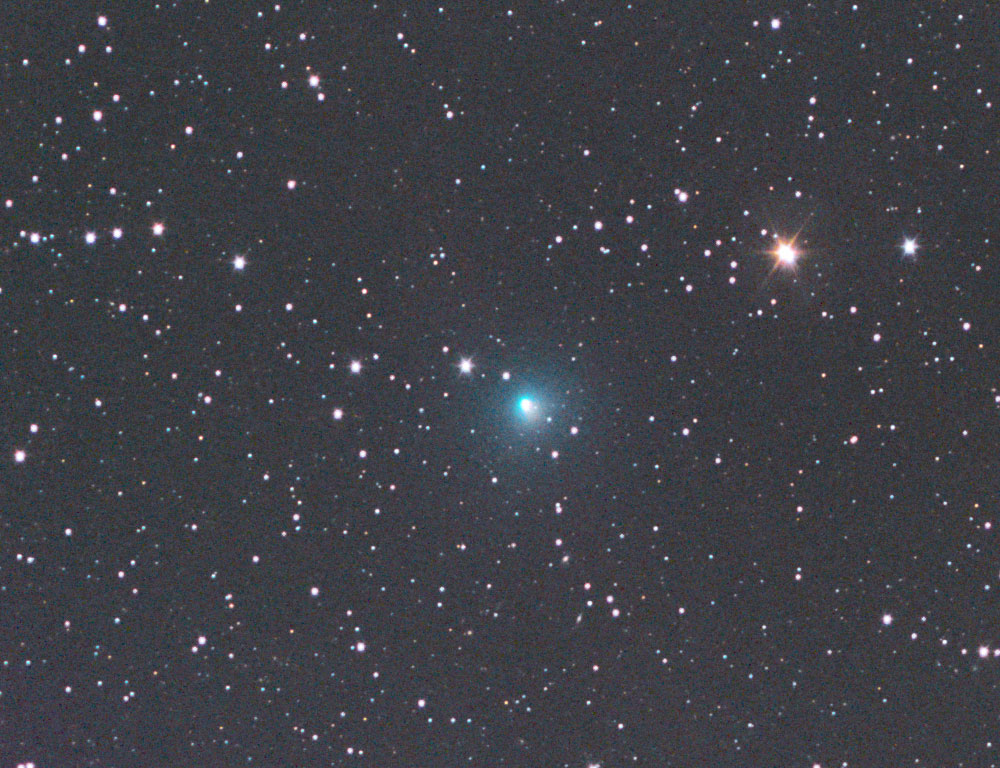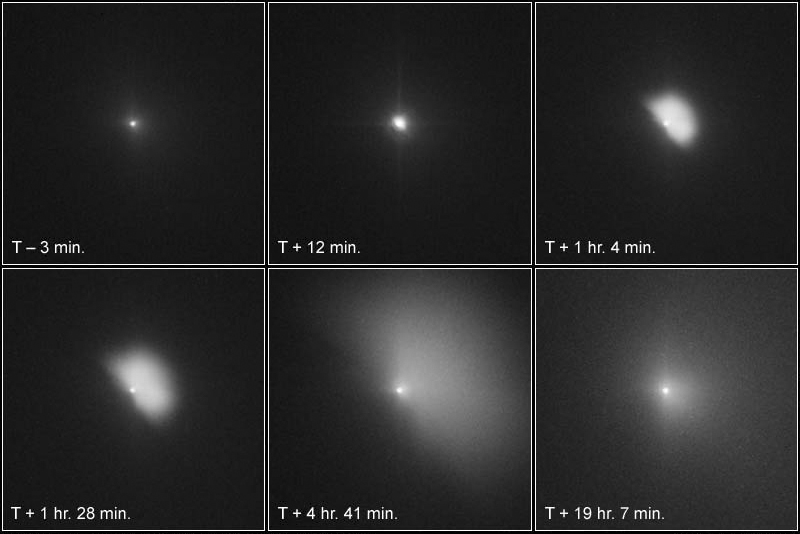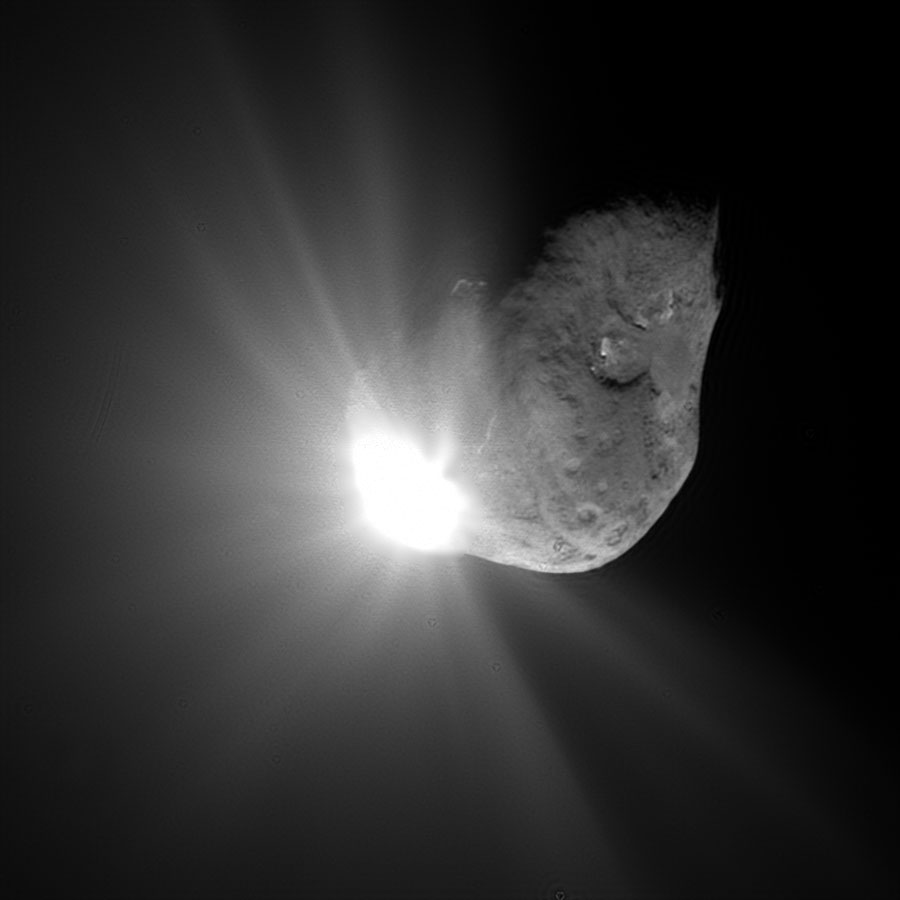

COMET OF THE WEEK
WEEK 28: JULY 5-11
COMET 9P/TEMPEL 1
Perihelion: 2005 July 5.31, q = 1.506 AU
A close approach to Jupiter (0.36 AU) in 1870 increased the comet’s perihelion distance to 1.77 AU and its orbital period to almost exactly six years, however the viewing geometry at both the 1873 and 1879 returns was quite favorable and it was successfully recovered both times. However, another close approach to Jupiter (0.55 AU) in 1881 increased the perihelion distance still further to 2.07 AU and the orbital period to 6.5 years, with the returns alternating between favorable and unfavorable. This, combined with the increased perihelion distance, created distinctly less favorable viewing conditions, and after unsuccessful recovery attempts at the next few returns the comet was considered “lost.”
During the early 1960s Yale University graduate student Brian Marsden – who would later become one of the top experts on cometary orbits in the world and who would for over two decades be Director of the IAU’s Minor Planet Center as well as its Central Bureau for Astronomical Telegrams – undertook a study (published in 1963) that analyzed several of the “lost” periodic comets and their prospects for future recovery. Marsden found that, during the intervening decades, additional close approaches to Jupiter had decreased Comet Tempel 1’s perihelion distance to less than what it was at the time of its discovery, and thus that it should be easily recoverable. The viewing geometry at the next perihelion passage, in early 1967, was very unfavorable, however later that year Elizabeth Roemer of the Lunar and Planetary Laboratory in Arizona took several photographs in an attempt to recover it, and while first inspections didn’t reveal anything, she later found a faint image on a single exposure taken on June 8 that was consistent with the comet’s location and motion. However, without any confirming photographs the recovery could not be considered “safe,” and any formal announcements of such were held in abeyance.
The viewing conditions at the comet’s subsequent return in 1972 were much more favorable, and on January 11 of that year Roemer, assisted by Larry Vaughn, successfully recorded the comet as an 18th-magnitude object on two photographs taken at Steward Observatory in Arizona. The actual time of perihelion passage turned out to be only two hours later than the predicted time, a most remarkable achievement considering that almost a century had elapsed since the last confirmed observations of the comet. Among other things, the recovery observations verified that the object Roemer had photographed in 1967 was indeed Comet Tempel 1.
In 1999 NASA approved the Deep Impact mission, with Comet Tempel 1 being the destination comet. Deep Impact was launched from Cape Canaveral, Florida on January 12,

2005, and on July 3 of that year the main spacecraft launched a 370-kg projectile which struck the comet's nucleus the following day. The overall intent of the Deep Impact mission was to excavate sub-surface cometary material and create a debris cloud that the main spacecraft would then subsequently fly through. This debris cloud was found to contain water ice as well as various silicates, hydrocarbons, metal sulfides (including iron pyrite, aka “fool’s gold”) among numerous other substances. The impact and debris cloud were detectable from Earth – a unique opportunity to observe real-time laboratory cometary science in action – and one of the observing platforms was NASA’s Submillimeter Wave Astronomy Satellite (SWAS), which was brought out of hibernation for the event; while SWAS detected water in the comet’s environment, it did not detect any excess amounts. The actual impact occurred at the wrong time of the night for me to observe, however on the first night after the impact the comet appeared to me to have brightened by almost a full magnitude and was distinctly more “condensed” in its interior, although these effects subsided during subsequent days.

 LEFT: Hubble Space Telescope images of the inner coma of Comet 9P/Tempel 1 before and after the Deep Impact impact on July 4, 2005; the time tags are referenced to the time of the impact. Images courtesy NASA. RIGHT: The nucleus of Comet Tempel 1 just over one minute after impact, as imaged by the Deep Impact flyby probe. Image courtesy NASA.
LEFT: Hubble Space Telescope images of the inner coma of Comet 9P/Tempel 1 before and after the Deep Impact impact on July 4, 2005; the time tags are referenced to the time of the impact. Images courtesy NASA. RIGHT: The nucleus of Comet Tempel 1 just over one minute after impact, as imaged by the Deep Impact flyby probe. Image courtesy NASA.

Comet Tempel 1 most recently passed through perihelion in August 2016, and was at aphelion (4.75 AU) in May 2019. The first post-aphelic images were obtained this past January by Francois Kugel and Claudine Rinner at the Observatoire Chante-Perdrix in Dauban, France. The comet next passes perihelion in early March 2022, although the viewing geometry is somewhat unfavorable. Some close approaches to Jupiter after that will once again move its perihelion distance out to 2 AU and it will remain a rather distant and faint object, although additional approaches to Jupiter during the 22nd Century will bring it back in again. On October 22, 2183, Comet Tempel 1 will pass only 0.02 AU from Mars, and if any human colonists are living on Mars at that time they should be able to enjoy some close-up views of this somewhat “renegade” comet that has made some interesting contributions to our understanding of these objects.
“Comet of the Week” archive
Ice and Stone 2020 home page
Earthrise Institute home page